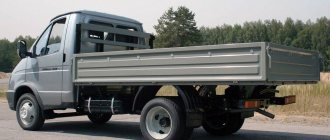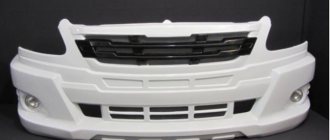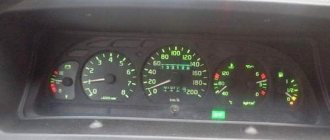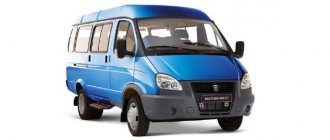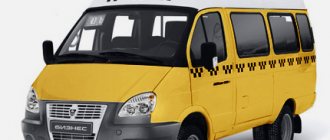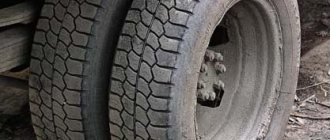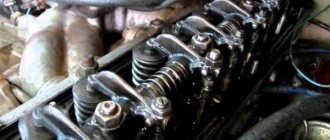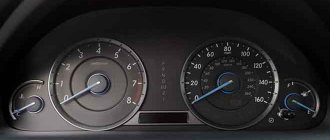The GAZelle-Next commercial vehicles were produced by the Gorky Automobile Plant back in 2013. Despite the modern design, comfort and quite affordable price, the new GAZelles are in no hurry to displace the previous GAZelle Business model from Russian roads.
The fact is that “Business” has proven itself excellent both in city traffic jams and in off-road conditions in the outback. It is distinguished by good driving performance, functionality and decent load capacity for its class. What do the GAZelle-Next developers offer us, besides a new design? Is this car really a class higher and more comfortable than the previous model? Or should the buyer choose an already proven and reliable “Business”? The main differences between the GAZelles “Next” and “Business” will be discussed in this article.
Body
Let's start with the appearance. The GAZelle “Next” cabin features an original design , with a stylish grille and modern-shaped headlights. It is safer than the Business cabin, as it is equipped with airbags and seat belts for the driver and passengers. Inside the cabin is spacious and comfortable. The driver's seat is adjustable in several directions, and the armrest can also be raised or lowered to the desired height. The instrument panel looks attractive and is convenient; the cabin has compartments for tools and a fire extinguisher. The cabin is equipped with an electric window, heated mirrors and many other small but convenient innovations.
GAZelle Next
Depending on the configuration, the GAZelle “Next” cabin can have a double row of seats that can accommodate 7 people, including the driver. At the same time, the rear row of seats has its own doors, which is convenient for boarding and disembarking passengers.
Gazelle Business
As for the dimensions of the car, they also differ. For the “Next” model they are:
- Length – 5.63 m.
- Width – 2.07 m.
- Height – 2.14 m.
While the dimensions of “Business” are somewhat different: width 1.97 m, height 2.5 m, and length can vary from 3 to 6 meters. The frame for these models is the same.
Hodovka
Let’s compare the suspensions of “Next” and “Business”: their chassis is significantly different; for the “Business” model it is a spring suspension with a beam.
This device undoubtedly has its advantages: it is excellent for off-road driving and can withstand heavy loads.
In a device of this type, running arms with balls allow the car to better maneuver and provide a comfortable ride.
The Next model has an independent suspension. Which one is better to choose mainly depends on. under what conditions the vehicle is planned to be used.
Engine
Business cars most often have an 8-valve engine produced by UMZ. This engine is easy to maintain and familiar to domestic consumers. As for power and efficiency, the Cummins ISF diesel turbocharged engine, which is installed on the GAZelle “Next”, surpasses the engines of the Ulyanovsk plant in these parameters. Since 2015, Next has also been equipped with a UMZ-A274 Evotech 2.7 gasoline engine, which is an alternative to a diesel engine.
The cooling of the GAZelle “Next” engine is more advanced compared to the “Business” one. The new model has an increased radiator area, which protects the car from overheating. This is especially true in urban environments, where the car is often stuck in traffic jams.
The gearbox of the models in question is identical. This five-speed manual transmission has proven itself over the years.
“3.5 hours under the car, and then I drove on”
We repaired foreign cars at a service station, but service prices were rising, so we decided to try GAZelle. When we took the first one and went to the service, we were not impressed with the competence of the mechanics and the cost of the work. We went on YouTube and started watching videos. We found a person on whose channel all types of repairs are laid out from A to Z.
The previously mentioned five-meter car constantly dragged a trailer behind it, as a result of which the gearbox regularly broke down. At first we gave it to specialists to repair, but after watching the videos we decided to try to sort out the box ourselves. Still, the repair kit costs about 70 Belarusian rubles, and for repairs at the service station they “charged” more than 400. The first time they spent two days on it, the second time they completed it in 20 hours, and the third and subsequent ones took 6 hours.
Replacing the clutch disc, which I did right today, took 3.5 hours under the car, and then I moved on. At the same time, you don’t need to carry any specialized tools with you; everything can be easily disassembled with ordinary keys. Here you have to rebuild the gearbox and change the clutch often.
Steering, brakes
How does the GAZelle “Next” brake system differ from its predecessor? First of all, these are anti-traction and anti-skid systems, which provide more effective braking and safety. In addition, “Next” has the following differences:
- Enlarged Bosch brake master cylinder.
- Improved hydraulic booster.
- High-quality brake discs with resistance to high temperatures.
Thanks to this, the braking distance of the GAZelle has been significantly reduced and is only 33 m at a speed of about 80 km/h.
The steering of the GAZelle “Business” and GAZelle “Next” is equipped with power steering, which allows you to put less effort into driving the car. Otherwise, the control system of these machines is completely different. The “Next” has a steering rack, like on a passenger car, which makes driving more comfortable.
All-metal van Gazelle Next
All-metal van GAZelle Next
All-metal van GAZelle Next
Modernization? Not at all! The new van is different from the old one in almost every way. Firstly, a new body made in the design of the Next generation. Moreover, the first in the family mastered the production of a van with a cargo compartment capacity of 13.5 cubic meters. m. This has never happened among GAZelles. In addition to the dimensions of the cargo compartment, the height of the side door opening has been increased by 414 mm and the height of the rear door opening has been increased by 431 mm.
Secondly, the interior has been completely updated. Comfortable seats, a height-adjustable steering wheel, an instrument panel with numerous containers and drawers, an advanced audio center, air conditioning, electric windows - the new car has all this either as standard or as additional equipment.
What to choose?
As we can see, there are much more differences between the considered models than common characteristics. GAZelle “Business” and GAZelle “Next” differ in all main parameters: engine, suspension and appearance. The control and brake systems have undergone significant changes. The interior of the Next is very different from the previous model, and is more reminiscent of a small foreign-made truck. At the same time, GAZelle “Business” is distinguished by the practicality and reliability of all elements. At the same time, it is also quite comfortable and maneuverable.
If you are faced with a choice of which model is better to purchase, consider first of all the operating conditions of the car, as well as how much time the driver plans to spend behind the wheel.
Auto and motorcycleComment
“When I go to Russia, I take a set of spare parts with me”
In summer the car gets very hot. You drive into Moscow, get stuck in a traffic jam, and the fan simply doesn’t turn off. The cooling system is not well thought out, which is why the “head” often blows on the fourth cylinder and the gasket burns out. This is a big problem. It is solved by two fans in front of the radiator and a button on the panel.
Weak cardan shaft crosspieces. In my last car I was driving a client around Minsk, and my crosspiece fell apart. The client is shocked by the roar and the sight of the cardan lying on the asphalt. I offer him options: find a replacement or just wait half an hour until everything is repaired. In 25 minutes I change the crosspiece, put everything together, the client has already managed to call someone, and then I ask: “Well, are we going?”
Gearboxes last a long time if you approach operation head-on. And in general, GAZelle is a car that you need to know how to drive. It doesn’t pull up to 2200 rpm at all; you need to constantly stay in the range of 2200-2500. The engine is very weak. When you go to Voronezh and the mountains begin, and you also have a loaded trailer, it comes to second gear.
The car does not like low-quality gasoline. Moreover, the Russian one is digested only by Lukoil. I don’t know what they do with it, but this winter my water froze in the tank and throughout the fuel line.
The advantage of a gasoline car is that it is very warm, even hot, in winter. You’re driving in severe frost in a T-shirt and shorts, steam is pouring out of the slightly open windows, everyone is looking at you.
The electrics here are frankly weak. The wiring is hidden inside the frame in a corrugation, dirt constantly flies there, everything turns green. You have to go through it regularly. The engine control electronics are also annoying. The crankshaft and camshaft sensors “die” just out of the blue. I don’t know what this is connected with.
Recently the muffler started leaking, a small hole, you can’t even hear it. Immediately the Check Engine light came on and the spark plugs began to flood.
When I go to Russia, I take with me a set of spare parts: a pump, a generator, a set of belts, a clutch disc and basket, a gearbox repair kit, a crankshaft sensor, a camshaft sensor, light bulbs, a couple of wires. I used to carry one wheel bearing, but it turned out to be the most useless thing.
GAZelle-BUSINESS: The same GAZelle, only better
Every Nizhny Novgorod resident has a special attitude towards the fate of GAZ cars... They are somehow our own, dear to us. Yes, we scold them, criticize designers and manufacturers, compare them with their foreign classmates, which are many times more expensive, but as practice shows, you can only make money on them. Moreover, GAZ has one advantage that not a single “Chinese” or “Russianized European” has - experience. The experience of thousands and thousands of drivers who have been operating Volgas, GAZelles, trucks for many years... From now on, GAZ decided to use its invaluable resource to the fullest and did this in relation to its most popular model - the GAZelle family car.
Design work on the new GAZelle-Business was started by GAZ specialists back in the crisis year of 2008. During this time, numerous studies have been conducted, surveys of dealers, service stations, consumers, and a study of the demand for spare parts. After performing statistical calculations, the GAZelle’s weakest points were identified and work began to eliminate them. Even the name “Business” was chosen by voting on the Internet. In total, more than 20 design and more than 130 production and technological changes were made to the car; components from leading foreign manufacturers were used in the systems, assemblies and components of the car. During testing, the car covered more than 2 million km.
To be honest, in preparation for the test drive of the new GAZelle, we read a lot of announcements, press releases and advertising brochures. It’s immediately clear that the GAZelle hasn’t changed much externally, but the manufacturer promises us a completely new car inside. In this regard, the main task of our test drive was to evaluate the practical changes in the car.
We arrived at the showroom of the official GAZ dealer, just after Bo Andersen announced the “National GAZelle Day” and the start of GAZelle-business sales. Right at the entrance we see two new GAZelles - a 7-seater cargo and passenger van and a 13-seater minibus. On the outside, the car is distinguished by a bumper of a different shape, with an integrated radiator grille (in other trim levels it can be painted in body color). Now the bumper is attached to the car’s cabin, and not to the frame as on the previous generation of GAZelles, this has made it possible to reduce the gap between the bumper and the cabin. The taillights have also undergone changes. The new large rear-view mirrors with turn signals and heating, even in the basic configuration, also caught the eye. There are eight available paint colors. Exterior changes end with a new emblem. Among the minuses, it is worth noting the poorly placed sound signals - salty winters do not like uncovered wires and contacts.
“We have already informed the GAZ team about the poor placement of the signals - they will correct it.” – comments Sergey Pankratov, driver.
- And do they really listen and correct? – we are surprised.
“They conducted a survey and found out about the shortcomings of the old model. I know for sure - almost everything that I proposed to fix has been fixed. I have driven thousands of kilometers on this car, I have traveled to Moscow, and I have been working on old GAZelles for many years. – Sergey answers, not without pleasure, which once again confirms that GAZ has begun to fully use the experience of the owners of its cars.
We open the driver's door and immediately understand that this is a completely new car! The instrument panel is from the German company EDAG, a new steering wheel with radio control buttons (they install German Blaupunkt). Stylish, modern, comfortable, functional. The silver color of the panel trim refreshes the interior, and the ignition switch operates with the same key that opens the door or trunk. The instrument panel now has three cup holders and three glove compartments, one of which is in A4 format. The cup holders and ashtray with microlift move out gently and are clearly fixed, no jamming.
An additional 12-volt power source has been installed on the panel, and interior lighting has been improved. The manufacturer talks about an improved heating system. The climate control system is controlled using an electronic unit, information from which is displayed on the LCD screen on the panel, and the system itself has a new stepper motor of a multi-stage 11-blade fan, a very useful air recirculation mode and a windshield defrosting mode! In addition, for winter, an increased capacity battery of 66 A/h, silicone high-voltage wires, and Brisk and Bosch spark plugs are installed. The windshield wiper has also been modernized - the number of brush strokes has increased, the clamping force has increased, the motor has more power, and new two-jet nozzles.
Overall, the interior was not just freshened up, but completely changed and left us with a very favorable impression; now it is in no way inferior to the interiors of Western commercial vehicles.
Road.
We get behind the wheel and discover another pleasant modification - an adjustable steering column, which many people know for this purpose. We test the car along the highway, or rather, along Larin Street, we leave for the countryside. Looking ahead, I will say that innovations have improved the GAZelle. The clutch pedal has really become like a passenger car (with less effort than the previous GAZelle) if in numbers - from 18 to 10 kg, the gears are engaged clearly and easily. Starting off is smooth, without jerks or vibrations. What changed the behavior of the GAZelle? The clutch is now imported from ZF Sachs (Germany), the gearbox has new bearings for the primary and secondary shafts from SKF (Germany), and Hoerbiger synchronizers (Germany). In addition, the manufacturer claims that leaks through the gearbox seals are excluded - they are also imported from Rubena (Czech Republic). All this together gives a good result.
What's hidden under the hood of GAZelle business? Familiar on the outside, unfamiliar on the inside, the Ulyanovsk UMZ 4216 engine, with Euro-3 toxicity standards. The power of this power unit is 123 hp at 4000 rpm. When driving, the engine feels supple, but not sluggish. According to Sergei, the power unit is free from an old disease - oil starvation. And it is more suitable for installing gas equipment.
The GAZelle business reaches the declared 130 kilometers per hour quite energetically, due to a change in the gear ratio in the main pair. At this speed, the background noise is slightly higher, but allows you to talk in the cabin without raising your voice. When driving outside the city limits, the cabin became even less noisy, which was done by increasing the rigidity of the doors and improved sound-proofing materials. The level of vibrations was also reduced - thanks to new engine mounts from ANVIS (Germany), with axial movement limiters and thermal shields for the supports. The air filter housing is now made of plastic. Refinement of the engine made it possible to reduce fuel consumption to 11.5 liters per 100 km. and this summer GAZ is going to release a GAZelle business with a diesel engine, but nothing is known about it yet...
The GAZelle business is managed, without undue modesty, perfectly, thanks to the German ZF power steering. The information content and feedback on the steering wheel has increased; it is very easy to predict what position the wheels are in at the moment and put them in the desired position. Maneuvering in urban conditions has become more pleasant. On the highway, the car does not scour the ruts, but clearly follows the trajectory set by the driver. The simulation of the rearrangement confirmed the expectations - the GAZelle is predictable and easy to control, even at high speeds. Steering movements are immediately transmitted to the wheels, with virtually no skidding or hesitation. Control is more predictable and not comparable to the previous GAZelle model! Branded shock absorbers make the car move smoother, and have a fairly large range (they do not respond to rebound), stability on the highway also deserves praise. Changing the front suspension, cardan drive, and rear axle allows you to get rid of extraneous noise when driving over uneven surfaces and eliminate vibrations.
When braking, the force on the pedal is easily dosed, the foot feels when it is necessary to press the pedal or release it - the merit of German components is the BOSCH vacuum booster (Germany). The clutch and brakes have one reservoir for two, which again simplifies the design and operation. The braking distance has been reduced by almost 3 meters (by 8%), in some trim levels of the GAZelle business a BOSCH anti-lock braking system (Germany) is installed.
Afterword.
GAZelle business is the same GAZelle, only better. The changes affected, first of all, the technical components of the car; what used to be the sore spots of the GAZelle have now become its advantage. In other words, the designers managed to get rid of old problems and make a high-quality product at an affordable price. Speaking of prices. The cost of the test copy was 470 thousand rubles. The cost of a regular onboard GAZelle starts at 425 thousand rubles. The previous GAZelle cost 395 thousand. The price has increased by 30 thousand, but the product is on a completely different level! At the same time, the vehicle's service life has increased to 300,000 km, the service interval is now 15 t.km, instead of the previous 10 t.km, and the warranty is up to 100 t.km. Let’s not forget about the recycling program for old cars, both federal (up to 50,000 rubles) and regional (up to 100,000 rubles). So it turns out that the cost of a GAZelle business when disposing of an old car can be only 275 000
rubles! Where else have you seen a new modern commercial vehicle for that kind of money?
Of course, after reading our material, it’s hard to believe that the familiar GAZelle has become so much better. We wouldn’t have believed it either if we hadn’t experienced everything ourselves, which we strongly advise you to do! Especially to all those who like to criticize the domestic auto industry, but never bothered to drive a Volga Siber or GAZelle for at least a couple of kilometers.
We tested GAZelle business at the Luidor car dealership on the street. Larina, 18, where the wait for a car for a test drive and an accompanying salon employee took us no more than a couple of minutes.
List of main changes in GAZelle Business:
The new “GAZelle-business” is a guarantee of up to 100 thousand km, a service interval of 15 thousand km, a vehicle life of 300 thousand km, steering with ZF power steering, gearbox (SKF bearings, Hoerbiger synchronizers), shock absorbers and clutch Sachs, BOSCH brakes, Anvis engine mounts, Bosch ignition coil, Tirsan Kardan cardan, Rubena cuffs, modernization of the engine, rear axle, gearbox, springs, front axle, intake system, increasing the corrosion resistance of the car (side, frame, transmission elements, springs, gas tank), high-capacity battery 66Ah, silicone high-voltage wires, Brisk, Bosch spark plugs, installation of a two-way Japanese T-Rad radiator, use of an 11-blade fan, new software, braking distance reduced by 8%, imported shock absorbers, higher performance windshield wipers , electrically heated mirrors, increased rigidity of the body and doors, an upgraded heater with increased performance, a silent multi-stage fan, a recirculation mode, a quick defrost function for the glass, an instrument panel (German company EDAG) with additional storage space, built-in cup holders, a new steering wheel and control levers , single key, control of the built-in radio on the steering wheel (optional), new integrated bumper with radiator trim, bumper and mirrors painted in body color (optional), new color scheme - 8 colors.
For any use of site materials, an active link to www.drivenn.ru is required.

